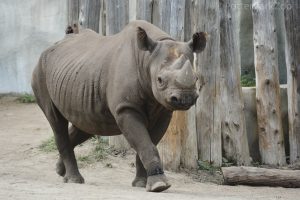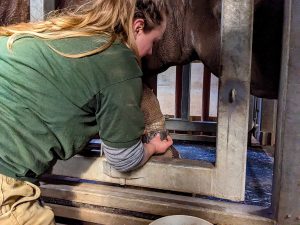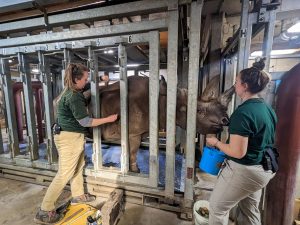 Potter Park Zoo’s veterinary and hoofstock team spent the last few months participating in the American Institute of Rhinoceros Science (AIRS) rhino study. This is a multi-institutional study led by six AZA facilities to help save rhinos from extinction and Potter Park Zoo will be participating in the study for multiple years. The four-part study focuses on improving the physical fitness, reproduction, well-being, and knowledge of iron storage disease in rhinos in an effort to improve the health of the AZA rhino populations. This research is vital in understanding and improving the care of rhinos in human care. This study includes several inter
Potter Park Zoo’s veterinary and hoofstock team spent the last few months participating in the American Institute of Rhinoceros Science (AIRS) rhino study. This is a multi-institutional study led by six AZA facilities to help save rhinos from extinction and Potter Park Zoo will be participating in the study for multiple years. The four-part study focuses on improving the physical fitness, reproduction, well-being, and knowledge of iron storage disease in rhinos in an effort to improve the health of the AZA rhino populations. This research is vital in understanding and improving the care of rhinos in human care. This study includes several inter esting and advanced techniques to gather information about rhinos.
esting and advanced techniques to gather information about rhinos.
As part of assessing the well-being of rhinos in human care, heart rate monitors and an ankle accelerometer monitor (~ to a “Fitbit”) are being placed on the rhinos. These tools help the researchers assess the rhinos’ activity and space use. By monitoring their movement and activity, we can understand their behavior and create an environment that meets their needs.
Weekly voluntary blood draws have allowed veterinary and animal care staff to submit serial blood samples so the researcher can better study rhino metabolism and also validated many tools to determine the body condition of these creatures. One tool that the researchers hope to validate is bioimpedance analysis which is a non-invasive method to provide an estimate of the rhinos body condition. This information helps us to understand the nutritional requirements of our rhinos, and how to provide a balanced diet that will keep them healthy.
Morphometric measurements provide quantitative analysis of weight, lengths, widths, masses, angles, ratios, and areas. By analyzing this data, we can calculate the rhino’s body mass index, which is an important indicator of the rhinos’ overall health.
In addition, animal care staff collect feces from the rhinos so that the researchers can measure reproductive hormones to better understand rhino reproduction. Fecal hormone monitoring, in addition to the blood samples and ultrasounds collected by veterinary staff, provide valuable information on rhino reproduction.
All of this information is crucial in providing the best care for these spectacular creatures. We are grateful for the team’s commitment to improving the care of rhinos and for making a positive impact on rhino conservation!



